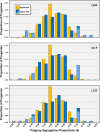Unexpected patterns of segregation distortion at a selfish supergene in the fire ant Solenopsis invicta
- PMID: 30404617
- PMCID: PMC6223060
- DOI: 10.1186/s12863-018-0685-9
Unexpected patterns of segregation distortion at a selfish supergene in the fire ant Solenopsis invicta
Abstract
Background: The Sb supergene in the fire ant Solenopsis invicta determines the form of colony social organization, with colonies whose inhabitants bear the element containing multiple reproductive queens and colonies lacking it containing only a single queen. Several features of this supergene - including suppressed recombination, presence of deleterious mutations, association with a large centromere, and "green-beard" behavior - suggest that it may be a selfish genetic element that engages in transmission ratio distortion (TRD), defined as significant departures in progeny allele frequencies from Mendelian inheritance ratios. We tested this possibility by surveying segregation ratios in embryo progenies of 101 queens of the "polygyne" social form (3512 embryos) using three supergene-linked markers and twelve markers outside the supergene.
Results: Significant departures from Mendelian ratios were observed at the supergene loci in 3-5 times more progenies than expected in the absence of TRD and than found, on average, among non-supergene loci. Also, supergene loci displayed the greatest mean deviations from Mendelian ratios among all study loci, although these typically were modest. A surprising feature of the observed inter-progeny variation in TRD was that significant deviations involved not only excesses of supergene alleles but also similarly frequent excesses of the alternate alleles on the homologous chromosome. As expected given the common occurrence of such "drive reversal" in this system, alleles associated with the supergene gain no consistent transmission advantage over their alternate alleles at the population level. Finally, we observed low levels of recombination and incomplete gametic disequilibrium across the supergene, including between adjacent markers within a single inversion.
Conclusions: Our data confirm the prediction that the Sb supergene is a selfish genetic element capable of biasing its own transmission during reproduction, yet counterselection for suppressor loci evidently has produced an evolutionary stalemate in TRD between the variant homologous haplotypes on the "social chromosome". Evidence implicates prezygotic segregation distortion as responsible for the TRD we document, with "true" meiotic drive the most likely mechanism. Low levels of recombination and incomplete gametic disequilibrium across the supergene suggest that selection does not preserve a single uniform supergene haplotype responsible for inducing polygyny.
Keywords: Colony social organization; Meiotic drive; Segregation distortion; Selfish genetic element; Supergene; Transmission ratio distortion.
Conflict of interest statement
Ethics approval and consent to participate
Consent for publication
Not applicable.
Competing interests
The authors declare that they have no competing interests.
Publisher’s Note
Springer Nature remains neutral with regard to jurisdictional claims in published maps and institutional affiliations.
Figures




Similar articles
-
Biased social chromosome transmission in males of the fire ant Solenopsis invicta.G3 (Bethesda). 2025 Feb 5;15(2):jkae289. doi: 10.1093/g3journal/jkae289. G3 (Bethesda). 2025. PMID: 39657264 Free PMC article.
-
Genomic architecture and evolutionary antagonism drive allelic expression bias in the social supergene of red fire ants.Elife. 2020 Aug 10;9:e55862. doi: 10.7554/eLife.55862. Elife. 2020. PMID: 32773032 Free PMC article.
-
Maternal effect killing by a supergene controlling ant social organization.Proc Natl Acad Sci U S A. 2020 Jul 21;117(29):17130-17134. doi: 10.1073/pnas.2003282117. Epub 2020 Jul 7. Proc Natl Acad Sci U S A. 2020. PMID: 32636262 Free PMC article.
-
Genetic regulation of colony social organization in fire ants: an integrative overview.Q Rev Biol. 2007 Sep;82(3):201-26. doi: 10.1086/519965. Q Rev Biol. 2007. PMID: 17937246 Review.
-
To b or not to b: a pheromone-binding protein regulates colony social organization in fire ants.Bioessays. 2005 Jan;27(1):91-9. doi: 10.1002/bies.20129. Bioessays. 2005. PMID: 15612031 Review.
Cited by
-
Bypassing Mendel's First Law: Transmission Ratio Distortion in Mammals.Int J Mol Sci. 2023 Jan 13;24(2):1600. doi: 10.3390/ijms24021600. Int J Mol Sci. 2023. PMID: 36675116 Free PMC article. Review.
-
Linked supergenes underlie split sex ratio and social organization in an ant.Proc Natl Acad Sci U S A. 2021 Nov 16;118(46):e2101427118. doi: 10.1073/pnas.2101427118. Proc Natl Acad Sci U S A. 2021. PMID: 34772805 Free PMC article.
-
Selfish migrants: How a meiotic driver is selected to increase dispersal.J Evol Biol. 2022 Apr;35(4):621-632. doi: 10.1111/jeb.13989. Epub 2022 Mar 7. J Evol Biol. 2022. PMID: 35255164 Free PMC article.
-
Unbalanced selection: the challenge of maintaining a social polymorphism when a supergene is selfish.Philos Trans R Soc Lond B Biol Sci. 2022 Aug;377(1856):20210197. doi: 10.1098/rstb.2021.0197. Epub 2022 Jun 13. Philos Trans R Soc Lond B Biol Sci. 2022. PMID: 35694754 Free PMC article.
-
Biased social chromosome transmission in males of the fire ant Solenopsis invicta.G3 (Bethesda). 2025 Feb 5;15(2):jkae289. doi: 10.1093/g3journal/jkae289. G3 (Bethesda). 2025. PMID: 39657264 Free PMC article.
References
-
- Burt A, Trivers R. Genes in conflict: the biology of selfish genetic elements. Cambridge: Harvard University Press; 2006.
Publication types
MeSH terms
Substances
Associated data
LinkOut - more resources
Full Text Sources
Other Literature Sources
Research Materials

